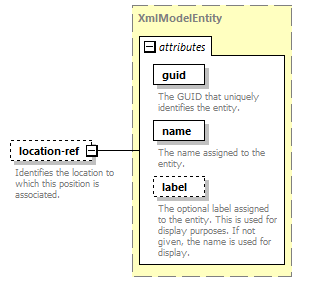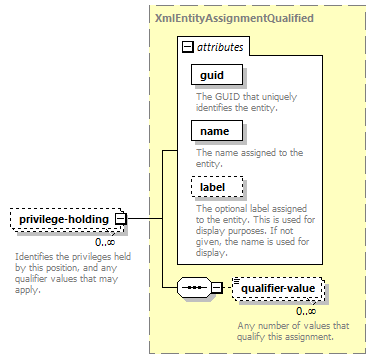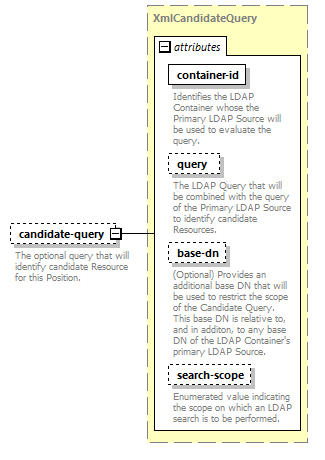| diagram |  |
||||||||||||||||||||||||||||||||||||||||||||||||||||||
| namespace | http://base.api.de.bpm.tibco.com | ||||||||||||||||||||||||||||||||||||||||||||||||||||||
| type | extension of XmlModelEntity | ||||||||||||||||||||||||||||||||||||||||||||||||||||||
| properties |
|
||||||||||||||||||||||||||||||||||||||||||||||||||||||
| children | schema-type allocation-method location-ref req-capability privilege-holding attribute push-destination candidate-query | ||||||||||||||||||||||||||||||||||||||||||||||||||||||
| attributes |
|
||||||||||||||||||||||||||||||||||||||||||||||||||||||
| annotation |
|
||||||||||||||||||||||||||||||||||||||||||||||||||||||
| source | <xs:complexType name="XmlBasePosition" abstract="true"> <xs:annotation> <xs:documentation>Describes an org-model Position and the associated entities.</xs:documentation> </xs:annotation> <xs:complexContent> <xs:extension base="XmlModelEntity"> <xs:sequence> <xs:element name="schema-type" type="XmlModelEntity" minOccurs="0" maxOccurs="1"> <xs:annotation> <xs:documentation>Describes the org-model schema type from which this position is derived. This is an optional element, as a position need not be derived from a schema type.</xs:documentation> </xs:annotation> </xs:element> <xs:element name="allocation-method" type="XmlSelectionMode" minOccurs="0" maxOccurs="1"> <xs:annotation> <xs:documentation>Describes the method of work allocation for this position.</xs:documentation> </xs:annotation> </xs:element> <xs:element name="location-ref" type="XmlModelEntity" minOccurs="0" maxOccurs="1"> <xs:annotation> <xs:documentation>Identifies the location to which this position is associated.</xs:documentation> </xs:annotation> </xs:element> <xs:element name="req-capability" type="XmlEntityAssignmentQualified" minOccurs="0" maxOccurs="unbounded"> <xs:annotation> <xs:documentation>Identifies a capability assignment that forms the collection of capabilities required to join this position.</xs:documentation> </xs:annotation> </xs:element> <xs:element name="privilege-holding" type="XmlEntityAssignmentQualified" minOccurs="0" maxOccurs="unbounded"> <xs:annotation> <xs:documentation>Identifies the privileges held by this position, and any qualifier values that may apply.</xs:documentation> </xs:annotation> </xs:element> <xs:element name="attribute" type="XmlOrgAttributeValue" minOccurs="0" maxOccurs="unbounded"> <xs:annotation> <xs:documentation>Names an attribute assigned to this position, and gives the definition for that attribute. Attributes can only be assigned to a position if it has a schema-type.</xs:documentation> </xs:annotation> </xs:element> <xs:element name="push-destination" type="XmlPushDestination" minOccurs="0" maxOccurs="unbounded"> <xs:annotation> <xs:documentation>Describes a Push Destinations, used to push work-items to Resources.</xs:documentation> </xs:annotation> </xs:element> <xs:element name="candidate-query" type="XmlCandidateQuery" minOccurs="0" maxOccurs="1"> <xs:annotation> <xs:documentation>The optional query that will identify candidate Resource for this Position.</xs:documentation> </xs:annotation> </xs:element> </xs:sequence> <xs:attribute name="ideal-number" type="xs:int" use="required"> <xs:annotation> <xs:documentation>For modelling purposes only, this returns the ideal number of resources that should be assigned to this Position. A position can be filled by any number of human resources, but an ideal number can be specified. This ideal number is merely an indication, and a lower or higher number of human resource assignments can be made.</xs:documentation> </xs:annotation> </xs:attribute> <xs:attribute name="calendar-alias" type="xs:string" use="optional"> <xs:annotation> <xs:documentation>The alias of the calendar that this position will use for deadline calculations. This information is only included if requested as part of the request parameters.</xs:documentation> </xs:annotation> </xs:attribute> <xs:attribute name="candidate-query" type="xs:boolean" use="optional"> <xs:annotation> <xs:documentation>Only used in the org-model drill-down API. Returns true if this Position holds a Candidate Query configuration. </xs:documentation> </xs:annotation> </xs:attribute> </xs:extension> </xs:complexContent> </xs:complexType> |
attribute XmlBasePosition/@ideal-number
| type | xs:int | ||
| properties |
|
||
| annotation |
|
||
| source | <xs:attribute name="ideal-number" type="xs:int" use="required"> <xs:annotation> <xs:documentation>For modelling purposes only, this returns the ideal number of resources that should be assigned to this Position. A position can be filled by any number of human resources, but an ideal number can be specified. This ideal number is merely an indication, and a lower or higher number of human resource assignments can be made.</xs:documentation> </xs:annotation> </xs:attribute> |
attribute XmlBasePosition/@calendar-alias
| type | xs:string | ||
| properties |
|
||
| annotation |
|
||
| source | <xs:attribute name="calendar-alias" type="xs:string" use="optional"> <xs:annotation> <xs:documentation>The alias of the calendar that this position will use for deadline calculations. This information is only included if requested as part of the request parameters.</xs:documentation> </xs:annotation> </xs:attribute> |
attribute XmlBasePosition/@candidate-query
| type | xs:boolean | ||
| properties |
|
||
| annotation |
|
||
| source | <xs:attribute name="candidate-query" type="xs:boolean" use="optional"> <xs:annotation> <xs:documentation>Only used in the org-model drill-down API. Returns true if this Position holds a Candidate Query configuration. </xs:documentation> </xs:annotation> </xs:attribute> |
element XmlBasePosition/schema-type
| diagram |  |
||||||||||||||||||||||||||||||
| type | XmlModelEntity | ||||||||||||||||||||||||||||||
| properties |
|
||||||||||||||||||||||||||||||
| attributes |
|
||||||||||||||||||||||||||||||
| annotation |
|
||||||||||||||||||||||||||||||
| source | <xs:element name="schema-type" type="XmlModelEntity" minOccurs="0" maxOccurs="1"> <xs:annotation> <xs:documentation>Describes the org-model schema type from which this position is derived. This is an optional element, as a position need not be derived from a schema type.</xs:documentation> </xs:annotation> </xs:element> |
element XmlBasePosition/allocation-method
| diagram |  |
||||||||||||||||||||||
| type | XmlSelectionMode | ||||||||||||||||||||||
| properties |
|
||||||||||||||||||||||
| attributes |
|
||||||||||||||||||||||
| annotation |
|
||||||||||||||||||||||
| source | <xs:element name="allocation-method" type="XmlSelectionMode" minOccurs="0" maxOccurs="1"> <xs:annotation> <xs:documentation>Describes the method of work allocation for this position.</xs:documentation> </xs:annotation> </xs:element> |
element XmlBasePosition/location-ref
| diagram |  |
||||||||||||||||||||||||||||||
| type | XmlModelEntity | ||||||||||||||||||||||||||||||
| properties |
|
||||||||||||||||||||||||||||||
| attributes |
|
||||||||||||||||||||||||||||||
| annotation |
|
||||||||||||||||||||||||||||||
| source | <xs:element name="location-ref" type="XmlModelEntity" minOccurs="0" maxOccurs="1"> <xs:annotation> <xs:documentation>Identifies the location to which this position is associated.</xs:documentation> </xs:annotation> </xs:element> |
element XmlBasePosition/req-capability
| diagram |  |
||||||||||||||||||||||||||||||
| type | XmlEntityAssignmentQualified | ||||||||||||||||||||||||||||||
| properties |
|
||||||||||||||||||||||||||||||
| children | qualifier-value | ||||||||||||||||||||||||||||||
| attributes |
|
||||||||||||||||||||||||||||||
| annotation |
|
||||||||||||||||||||||||||||||
| source | <xs:element name="req-capability" type="XmlEntityAssignmentQualified" minOccurs="0" maxOccurs="unbounded"> <xs:annotation> <xs:documentation>Identifies a capability assignment that forms the collection of capabilities required to join this position.</xs:documentation> </xs:annotation> </xs:element> |
element XmlBasePosition/privilege-holding
| diagram |  |
||||||||||||||||||||||||||||||
| type | XmlEntityAssignmentQualified | ||||||||||||||||||||||||||||||
| properties |
|
||||||||||||||||||||||||||||||
| children | qualifier-value | ||||||||||||||||||||||||||||||
| attributes |
|
||||||||||||||||||||||||||||||
| annotation |
|
||||||||||||||||||||||||||||||
| source | <xs:element name="privilege-holding" type="XmlEntityAssignmentQualified" minOccurs="0" maxOccurs="unbounded"> <xs:annotation> <xs:documentation>Identifies the privileges held by this position, and any qualifier values that may apply.</xs:documentation> </xs:annotation> </xs:element> |
element XmlBasePosition/attribute
| diagram |  |
||||||
| type | XmlOrgAttributeValue | ||||||
| properties |
|
||||||
| children | definition value | ||||||
| annotation |
|
||||||
| source | <xs:element name="attribute" type="XmlOrgAttributeValue" minOccurs="0" maxOccurs="unbounded"> <xs:annotation> <xs:documentation>Names an attribute assigned to this position, and gives the definition for that attribute. Attributes can only be assigned to a position if it has a schema-type.</xs:documentation> </xs:annotation> </xs:element> |
element XmlBasePosition/push-destination
| diagram |  |
||||||||||||||||||||||||||||||||||||||||||||||
| type | XmlPushDestination | ||||||||||||||||||||||||||||||||||||||||||||||
| properties |
|
||||||||||||||||||||||||||||||||||||||||||||||
| children | value | ||||||||||||||||||||||||||||||||||||||||||||||
| attributes |
|
||||||||||||||||||||||||||||||||||||||||||||||
| annotation |
|
||||||||||||||||||||||||||||||||||||||||||||||
| source | <xs:element name="push-destination" type="XmlPushDestination" minOccurs="0" maxOccurs="unbounded"> <xs:annotation> <xs:documentation>Describes a Push Destinations, used to push work-items to Resources.</xs:documentation> </xs:annotation> </xs:element> |
element XmlBasePosition/candidate-query
| diagram |  |
||||||||||||||||||||||||||||||||||||||
| type | XmlCandidateQuery | ||||||||||||||||||||||||||||||||||||||
| properties |
|
||||||||||||||||||||||||||||||||||||||
| attributes |
|
||||||||||||||||||||||||||||||||||||||
| annotation |
|
||||||||||||||||||||||||||||||||||||||
| source | <xs:element name="candidate-query" type="XmlCandidateQuery" minOccurs="0" maxOccurs="1"> <xs:annotation> <xs:documentation>The optional query that will identify candidate Resource for this Position.</xs:documentation> </xs:annotation> </xs:element> |
WSDL documentation generated by XMLSpy WSDL Editor http://www.altova.com/xmlspy